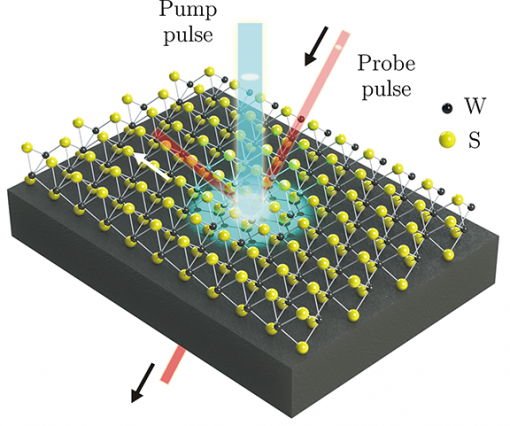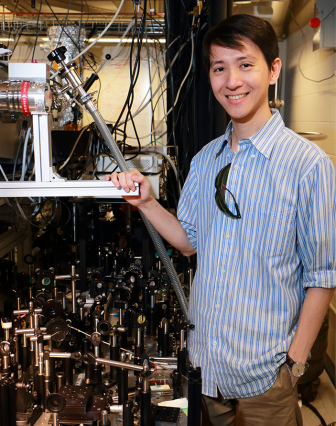Grad student discovers unique valleytronics properties of tungsten disulfide monolayer film

Monolayer films of tungsten disulfide, just three atoms thick, have unique electronic valleys which can be manipulated with laser light. This finding, by MIT physics graduate student Edbert Jarvis Sie, Associate Professor Nuh Gedik, and colleagues, was significant enough to warrant placement on the cover of Nature Materials earlier this year.
The cover illustrates a tornado-like whorl of light, lifting an electronic band in the material to a higher energy state, which widens the band gap in the material. This widening is known as the optical Stark effect. The researchers, under senior author Nuh Gedik, the Lawrence C. (1944) and Sarah W. Biedenharn Career Development Associate Professor of Physics at MIT, found that applying circularly polarized laser light lifted the energy in one valley while leaving the energy in the other valley unaffected. "There are two valleys. If we switch the laser polarization, the effect switches to the other valley," Sie says. Gedik spoke about his group's research on topological insulators at the Materials Day Symposium, on Oct. 14, in Kresge Auditorium.
"In materials, electrons travelling in different directions experience different scattering potential with the atoms. This establishes an energy landscape as a function of electron's momentum, which can form a local minimum that we call a valley," Sie explains. "The phenomenon of the valleys only occurs in these extremely thin, monolayer forms of the tungsten sulfur compound, not in its bulk form. These valleys normally have the same energy. But as we apply this circularly polarized light, we can lift the energy of one valley relative to the other."
Seeking chiral edge state
Sie is continuing the research by leading an effort to demonstrate a phenomenon predicted by MIT assistant professor of physics Liang Fu that electrons at the boundary of the laser spot will travel clockwise or counterclockwise depending on their spin and the light polarization, thus creating the so-called chiral edge state. "Research is currently ongoing in order to establish this new phase of matter and to observe it," Sie says. The chiral edge state is predicted to occur in the valley opposite to the one whose bandgap is affected by the circularly polarized light.

This valley degree of freedom, or valley index, has a potential to be used for carrying information like in a computer. Transistors nowadays are reaching a fundamental size limit that is either difficult or too expensive to overcome, and monolayer materials like tungsten disulfide may have the capability to carry the next generation of electronics, Sie suggests.
Previous approaches to creating topological insulators involved layering materials such as mercury telluride with cadmium telluride or alloying a material such as thallium bismuth sulfide with an additional element such as selenium, Sie explains. "In our new approach that we are trying to do, we don't need to do any sandwiching or putting additional elements," Sie says. "We take this normal material, a semiconductor, and we just shine light to turn it into a topological insulator."
On-off switch
"By turning on the laser light, we can have a topological insulator; by turning it off, we can have back our semiconductor from the same piece of material. Because this material has a valley index, which is unique, then we can have this sort of valley-flavored topological insulator," he explains.
Sie, 29, who is from Indonesia, is a fifth-year graduate student in physics and expects to graduate in fall 2017. He earned his bachelor's degree in physics at Nanyang Technological University in Singapore. He was a silver medalist in the 2004 International Physics Olympiad, held that year in South Korea. Since his early years, Sie also enjoyed drawing and painting, and earlier considered becoming an artist. That interest came into play when he came up with a sketch for the image that eventually became the cover for his Nature Materials article.
More information: Edbert J. Sie et al. Valley-selective optical Stark effect in monolayer WS2, Nature Materials (2014). DOI: 10.1038/nmat4156
Journal information: Nature Materials
Provided by Massachusetts Institute of Technology
This story is republished courtesy of MIT News (web.mit.edu/newsoffice/), a popular site that covers news about MIT research, innovation and teaching.





















